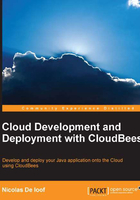
Platform as a Service
Platform as a Service (PaaS) is a crossover between IaaS and SaaS. This is a fuzzy definition, but it defines well the existing actors in this industry well and possible confusions. A general presentation of PaaS uses a pyramid. Depending on what the graphics try to demonstrate, the pyramid can be drawn upside down, as shown in the following diagram:

Cloud pyramids
The pyramid on the left-hand side shows XaaS platforms based on the target users' profiles. It demonstrates that IaaS is the basis for all Cloud services. It provides the required flexibility for PaaS to support applications that are exposed as SaaS to the end users. Some SaaS actually don't use a PaaS and directly rely on IaaS, but that doesn't really matter here.
The pyramid on the right-hand side represents the providers and the three levels suggests the number of providers in each category. IaaS only makes sense for highly concentrated, large-scale providers. PaaS can have more actors, probably focused on some ecosystem, but the need is to have a neutral and standard platform that is actually attractive for developers. SaaS is about all the possible applications running in Cloud. The top-level shape should then be far larger than what the graphic shows.